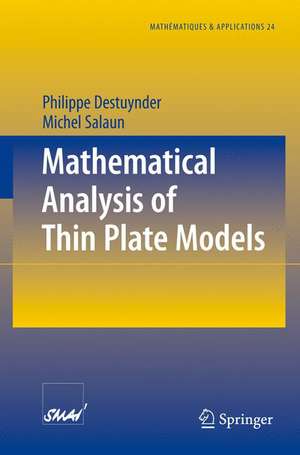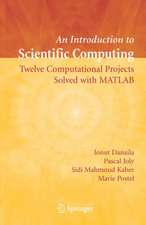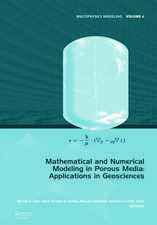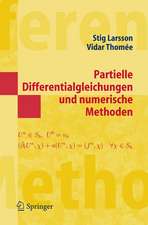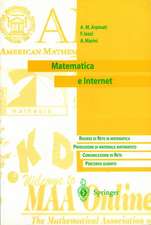Mathematical Analysis of Thin Plate Models: Mathématiques et Applications, cartea 24
Autor Philippe Destuynder, Michel Salaunen Limba Engleză Paperback – 26 iul 1996
Din seria Mathématiques et Applications
-
 Preț: 377.19 lei
Preț: 377.19 lei -
 Preț: 385.47 lei
Preț: 385.47 lei -
 Preț: 261.32 lei
Preț: 261.32 lei -
 Preț: 482.74 lei
Preț: 482.74 lei - 15%
 Preț: 636.76 lei
Preț: 636.76 lei -
 Preț: 323.28 lei
Preț: 323.28 lei - 15%
 Preț: 524.14 lei
Preț: 524.14 lei -
 Preț: 396.40 lei
Preț: 396.40 lei -
 Preț: 316.71 lei
Preț: 316.71 lei -
 Preț: 262.68 lei
Preț: 262.68 lei -
 Preț: 388.52 lei
Preț: 388.52 lei - 20%
 Preț: 331.58 lei
Preț: 331.58 lei -
 Preț: 316.91 lei
Preț: 316.91 lei - 15%
 Preț: 466.87 lei
Preț: 466.87 lei -
 Preț: 390.63 lei
Preț: 390.63 lei -
 Preț: 391.61 lei
Preț: 391.61 lei -
 Preț: 390.46 lei
Preț: 390.46 lei -
 Preț: 497.00 lei
Preț: 497.00 lei -
 Preț: 315.77 lei
Preț: 315.77 lei -
 Preț: 388.90 lei
Preț: 388.90 lei -
 Preț: 315.77 lei
Preț: 315.77 lei -
 Preț: 354.17 lei
Preț: 354.17 lei - 20%
 Preț: 335.36 lei
Preț: 335.36 lei -
 Preț: 348.00 lei
Preț: 348.00 lei -
 Preț: 393.35 lei
Preț: 393.35 lei -
 Preț: 397.01 lei
Preț: 397.01 lei - 15%
 Preț: 468.25 lei
Preț: 468.25 lei -
 Preț: 385.08 lei
Preț: 385.08 lei -
 Preț: 388.13 lei
Preț: 388.13 lei -
 Preț: 392.97 lei
Preț: 392.97 lei -
 Preț: 315.77 lei
Preț: 315.77 lei -
 Preț: 394.12 lei
Preț: 394.12 lei -
 Preț: 453.51 lei
Preț: 453.51 lei - 20%
 Preț: 331.25 lei
Preț: 331.25 lei -
 Preț: 389.88 lei
Preț: 389.88 lei -
 Preț: 330.75 lei
Preț: 330.75 lei -
 Preț: 401.42 lei
Preț: 401.42 lei -
 Preț: 450.31 lei
Preț: 450.31 lei -
 Preț: 330.75 lei
Preț: 330.75 lei -
 Preț: 484.43 lei
Preț: 484.43 lei -
 Preț: 475.87 lei
Preț: 475.87 lei - 19%
 Preț: 412.95 lei
Preț: 412.95 lei - 15%
 Preț: 532.55 lei
Preț: 532.55 lei -
 Preț: 366.51 lei
Preț: 366.51 lei -
 Preț: 391.61 lei
Preț: 391.61 lei -
 Preț: 394.87 lei
Preț: 394.87 lei -
 Preț: 463.79 lei
Preț: 463.79 lei -
 Preț: 500.08 lei
Preț: 500.08 lei -
 Preț: 389.49 lei
Preț: 389.49 lei
Preț: 385.62 lei
Nou
Puncte Express: 578
Preț estimativ în valută:
73.81€ • 80.20$ • 62.04£
73.81€ • 80.20$ • 62.04£
Carte tipărită la comandă
Livrare economică 21 aprilie-05 mai
Preluare comenzi: 021 569.72.76
Specificații
ISBN-13: 9783540611677
ISBN-10: 3540611673
Pagini: 252
Ilustrații: X, 236 p. 39 illus.
Dimensiuni: 156 x 244 x 13 mm
Greutate: 0.36 kg
Ediția:1996
Editura: Springer Berlin, Heidelberg
Colecția Springer
Seria Mathématiques et Applications
Locul publicării:Berlin, Heidelberg, Germany
ISBN-10: 3540611673
Pagini: 252
Ilustrații: X, 236 p. 39 illus.
Dimensiuni: 156 x 244 x 13 mm
Greutate: 0.36 kg
Ediția:1996
Editura: Springer Berlin, Heidelberg
Colecția Springer
Seria Mathématiques et Applications
Locul publicării:Berlin, Heidelberg, Germany
Public țintă
GraduateCuprins
I — Plate models for thin structures.- I.0 — A short description of the chapter.- I.1 — The three dimensionnal elastic-model.- I.2 — The Kirchhoff-Love assumption.- I.3 — The Kirchhof f-Love plate model.- I.4 — The Naghdi model revisited using mixed variational formulation.- I.5 — About the rest of the book.- References of Chapter I.- II — Variational formulations for bending plates.- II.0 — A brief summary of the chapter.- II. 1 — Why a mixed formulation for plates.- II.2 — The primal variational formulation for Kirchhoff-Love model.- II.3 — The Reissner-Mindlin-Naghdi model for plates.- II.4 — Natural duality techniques for the bending plate model.- II.5 — A comparison between the mixed method and the one of section II.2.4.- References of Chapter II.- III — Finite element approximations for several plate models.- III.0 — A summary of the chapter.- III. 1 — Basic results in finite element approximation.- III.2 — C1 elements.- III.3 — Primal finite element methods for bending plates.- III.4 — The penalty-duality finite element method for the bending plate model.- III.5 — Numerical approximation of the mixed formulation for a bending plate.- References of Chapter III.- IV — Numerical tests for the mixed finite element schemes.- IV.0 — A brief description of the chapter.- IV. 1 — Precision tests for the mixed formulation.- IV.2 Vectorial and parallel algorithms for mixed elements.- IV.3 — Concluding remarks.- References of Chapter IV.- V — A Numerical model for delamination of composite plates.- V.O — A brief description of the chapter.- V. 1 — What is delamination of thin multilayered plates.- V.2 — The three-dimensional multilayered composite plate model with delamination.- V.3 — A plate model for largedelamination.- V.4 — The three-dimensional energy release rate.- V.5 — The mechanical example and the numerical method.- V.6 — Concluding remarks.- References of Chapter V.
Textul de pe ultima copertă
Ce livre est destiné aux enseignants, chercheurs et étudiants désireux de se familiariser avec les différents modèles de plaques minces et d'en maîtriser les problèmes mathématiques et d'approximation sous-jacents. Il contient essentiellement des résultats nouveaux et des applications originales à l'étude du délaminage des structures multicouche. La démarche est guidée par un souci de mettre en avant les points délicats dans la théorie des plaques minces.
